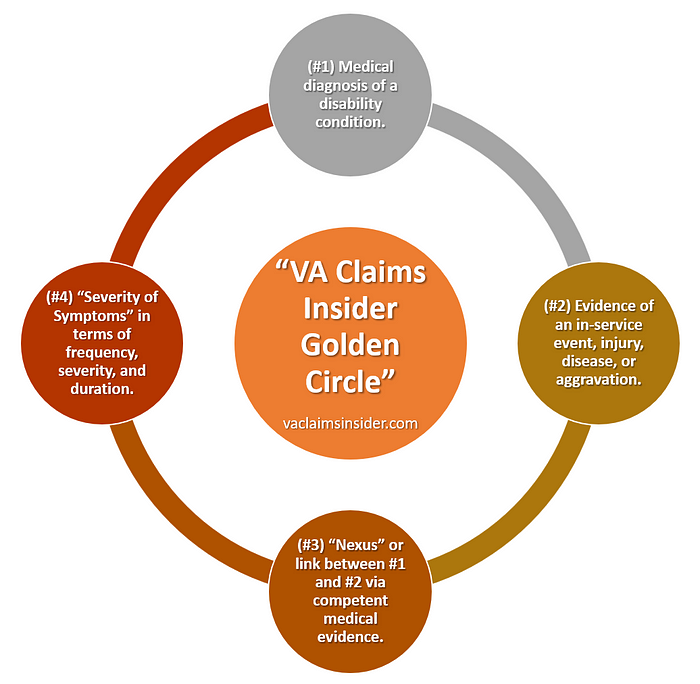
How to Prove Your VA Disability with The VA Claims Insider Golden Circle!
To establish a valid VA disability claim, veterans must meet four key requirements.
Known as “The VA Claims Insider Golden Circle,” these steps are based on The Caluza Triangle, a landmark case that set the foundational criteria for VA claim approvals.
We’ve added a fourth essential element: “Severity of Symptoms,” which is crucial for determining the final VA rating for each condition.
In this article, Air Force veteran and VA disability claims expert Brian Reese explains how to use “The VA Claims Insider Golden Circle” to win your VA claim faster, establish service connection, and secure the VA rating and compensation you’ve earned.
You Might Also Like the Following Blog Posts
- The 5 Types of VA Service Connection
- 15 Most Common Reasons for VA Claim Denials and How to Fight Back!
- Brian Reese Reveals 10 SECRET VA Disability Claim Tips & Strategies!
The VA Claims Insider Golden Circle Explained

Here’s the four required elements for all VA claims, assuming a veteran is eligible for VA disability benefits under the law.
It’s called “The VA Claims Insider Golden Circle”
- #1. Diagnosis of a current disability in a medical record. If yes, go to step #2. This must be in a medical record.
- #2. Evidence of an in-service event, injury, disease, or aggravation. If yes, go to step #3.
- #3. “Nexus” meaning link or connection between #1 and #2 above via competent medical evidence. If yes, go to step #4. A Nexus Letter from a private provider can really help you prove your nexus on an “at least as likely as not” basis!
- #4. “Severity of symptoms” in terms of frequency (how often), severity (how bad), and duration (how long) as well as how these symptoms negatively impact your work, life, and social functioning. This is the final step in The Caluza Triangle and it’s what determines your final VA rating percentage.
#1. Diagnosis of a Current Disability in a Medical Record
Requirement: Veterans must have a formal diagnosis of the disability they are claiming, which must be documented in an official medical record. This can be in your military medical records, VA medical records, private medical records, or Disability Benefit Questionnaires (DBQs).
Why It Matters: The VA won’t consider a disability claim without a current diagnosis. This diagnosis proves that the veteran is actively dealing with a health condition, rather than a past or temporary issue.
Example: A veteran seeking disability benefits for PTSD needs a formal PTSD diagnosis in their medical records from a mental health professional. The diagnosis must meet the DSM-5 (Diagnostic and Statistical Manual of Mental Disorders, Fifth Edition) criteria for PTSD to be considered valid by the VA.
#2. Evidence of an In-Service Event, Injury, Disease, or Aggravation
Requirement: The veteran must show that something happened during their military service that either caused, aggravated, or worsened their condition. This can be in medical records, personnel records, lay evidence, among many other possible sources.
Why It Matters: This is the foundation of service connection; it ties the disability to the veteran’s military service. Without evidence of an in-service event or injury, the VA may deny that the disability is conneced to service.
Examples:
- Direct Service Connection: A veteran developed hearing loss due to exposure to loud noises in combat, documented in military records. This direct connection to combat noise exposure establishes a clear link to service.
- Secondary Service Connection: A veteran with service-connected tinnitus (ringing in the ears) later develops chronic migraines. Since migraines can be linked to tinnitus, the migraines may qualify for secondary service connection, meaning they stem from an existing service-connected condition.
- Secondary Service Connection via Aggravation: A veteran has a service-connected knee injury from military service, which causes a limp due to chronic pain and instability. Over time, this altered gait leads to increased strain on the veteran’s lower back, resulting in chronic back pain. In this scenario, while the back condition didn’t start in service, it was aggravated by the altered gait caused by the service-connected knee injury. The back problems would qualify for secondary service connection because they were aggravated by the knee injury’s impact on the veteran’s mobility.
- Aggravation of a Pre-Service Disability: A veteran had a pre-existing condition, such as asthma, before enlisting. During service, the condition worsened significantly due to environmental factors, like exposure to dust or chemicals during deployment. For this aggravation claim, the veteran must demonstrate that the condition got worse due to service factors rather than its natural progression.
- Presumptive Service Connection: A Vietnam veteran develops type 2 diabetes years after service. Since the VA recognizes type 2 diabetes as a condition associated with Agent Orange exposure, which was common in Vietnam, the veteran can be granted a presumptive service connection without needing to prove direct exposure to the chemical or link it directly to service.
#3. Nexus (Link or Connection) Between the Current Disability and In-Service Event, Injury, Disease, or Aggravation
Requirement: The veteran must establish a link, or “nexus,” on a 50/50 basis or “at least as likely as not” between the in-service event, injury, disease, or aggravation, and their current disability through credible medical evidence. For secondary service connection, the nexus must show that the new condition is proximately due to, caused, or aggravated by the service-connected condition.
Why It Matters: The “nexus” is the critical element that bridges the gap between service and disability, showing that the in-service event directly contributed to or caused the current condition. A strong nexus letter is often necessary, particularly if the veteran has been out of the military for more than 12 months. A nexus letter is mission critical for secondary service connection.
The Role of a Nexus Letter: A strong Nexus Letter from a qualified healthcare provider (often a private physician who specializes in medical evidence for VA disability claims) can provide a compelling argument that a disability should be service-connected. In the letter, the provider should explain the medical basis for the connection, using clinical evidence, medical literature, or known associations between the service event and the condition.
Example: A veteran with PTSD receives an independent psychological evaluation and nexus letter from a psychologist who explains that the veteran’s PTSD symptoms are “at least as likely as not” (the VA’s standard for probability) caused by exposure to traumatic events during deployment.
#4. Severity of Symptoms in Terms of Frequency, Severity, Duration, and How These Symptoms Negatively Impact a Veteran’s Work, Life, and Social Functioning
Requirement: The veteran must demonstrate the severity of their symptoms, including their frequency (how often symptoms occur), severity (intensity of symptoms), and duration (how long symptoms last), and explain how these symptoms negatively affect their work, life, and social functioning.
Why It Matters: This step determines the VA rating percentage for the disability, which directly impacts the level of compensation awarded. Higher levels of severity and greater functional impact generally correspond to higher ratings and thus higher monthly compensation.
How to Document Severity of Symptoms: Medical evidence of severity of symptoms is mission critical! Veterans are also encouraged to provide lay evidence that illustrates the impact of their condition on daily life. Additionally, input from family members, co-workers, or friends who observe the condition’s effects can add credibility.
Example: For a veteran with chronic migraines secondary to tinnitus, the severity might be documented in a medical record as follows:
- Frequency: Migraines occur two to three times per week on average.
- Severity: The veteran’s migraines cause intense pain on both sides of the head, resulting in frequent missed workdays and a reduced ability to perform daily tasks. To manage the pain, they must lie down in a dark room with noise-canceling headphones for extended periods.
- Duration: Each migraine lasts between four and eight hours and requires medication and bed rest.
- Proof: Medical evidence in VA medical records as well as the veteran’s evidence of frequency, severity, and duration of headaches from the Migraine Buddy app.
Fellow Veterans: Do You Want to WIN Your VA Disability Claim FASTER?
Need expert-level VA claim help? Call us right now: (281) 533–6777.
Hi fellow veterans, I’m Brian Reese, the VA Claims Insider, and I’m here to help you INCREASE your VA rating FASTER — even if you’ve already filed, been denied, gave up, or don’t know where to start…
If you’re frustrated, underrated, or simply sick and tired of fighting the VA alone, I’ve got your six!
There’s always another path available to you, and I’m committed to helping you achieve VA claim victory.
My process starts with a one-on-one phone call so we can get to know your unique claim situation.
We’ll identify where you stand now, where you want to go, and how we make it happen with the right medical evidence.
If we nail your VA claim strategy, the tactics become simple and easy!
Through this gap analysis process, we’ll build a personalized VA claim strategy tailored to your needs — designed to give you the best possible chance of securing the VA rating and compensation you’ve earned for serving our country.
>> Click Here to book your no-obligation consultation or call us right now at (281) 533–6777.
About the Author

Brian Reese is one of the world’s top VA disability experts and the #1 bestselling author of VA Claim Secrets and You Deserve It. Frustrated with the VA claim process, Brian founded VA Claims Insider to help disabled veterans win their VA disability compensation faster. He has served over 10 million military members and veterans since 2013. A former Air Force officer, Brian deployed to Afghanistan in 2011. He is a Distinguished Graduate from the U.S. Air Force Academy and holds an MBA from Oklahoma State University, where he was a National Honor Scholar.
